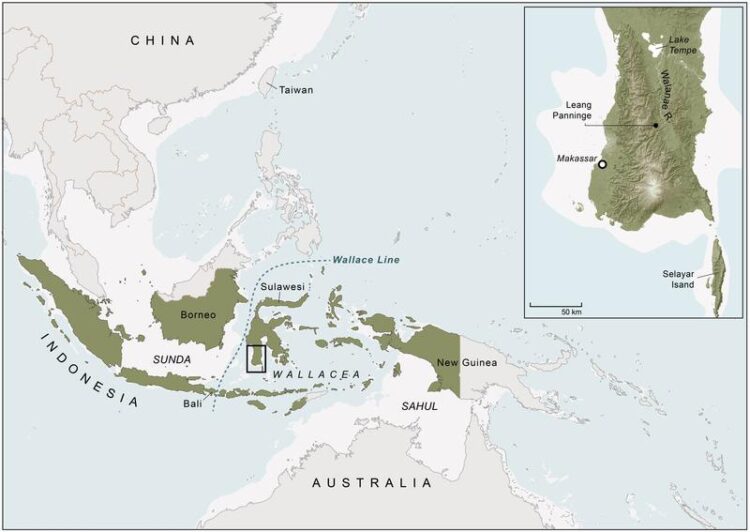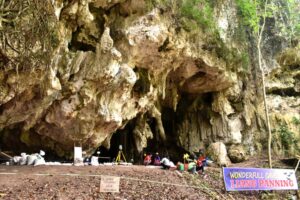Oldest genome from Wallacea shows previously unknown ancient human relations

The map of Southeast Asia shows the Wallacea area as well as the island of Sulawesi, enlarged the southern part of the island with the Leang Panninge cave.
Image: Kim Newman
International research team isolates DNA from modern human buried 7,000 years ago on the Indonesian island of Sulawesi.

Leang Panninge Cave (‘Bat Cave’) on the southern peninsula of Sulawesi, Indonesia.
Image: Leang Panninge Research Project
The oldest genome of a modern human from the Wallacea region – the islands between western Indonesia and Papua New Guinea – indicates a previously undescribed ancient human relationship. Researchers were able to isolate sufficient genetic material from the skull of an individual buried more than 7,000 years ago on the Indonesian island of Sulawesi. It belonged to a hunter-gatherer society and was interred at the site now called Leang Panninge (‘Bat Cave’). A large part of the genetic code matched that of today’s Papua New Guineans and Aboriginal Australians. Yet portions of the genome did not match these groups. This brings new surprises about the evolution of modern humans.
The international study was accomplished through close collaboration with several researchers and institutions from Indonesia. It was headed by Professor Johannes Krause of the Max Planck Institutes for Evolutionary Anthropology in Leipzig and the Science of Human History in Jena, Professor Cosimo Posth of the Senckenberg Centre for Human Evolution and Palaeoenvironment at the University of Tübingen, and Professor Adam Brumm of Griffith University, Australia. The study has been published in the latest edition of Nature.
Almost completely preserved skeleton
The Wallacean Islands formed stepping stones in the spread of the first modern humans from Eurasia to Oceania, probably more than 50,000 years ago. Archaeological finds show that the ancestors of our species lived in Wallacea as early as 47,000 years ago. Yet few human skeletons have been found. One of the most distinctive archaeological discoveries in this region is the Toalean technology complex, dated to a much more recent period between 8,000 and 1,500 years ago. Among the objects manufactured by the people of the Toalean culture are the characteristic stone arrowheads known as Maros points. The Toalean culture has only been found in a relatively small area on the southern peninsula of Sulawesi. “We were able to assign the burial at Leang Panninge to that culture,” says Adam Brumm. “This is remarkable since it is the first largely complete and well preserved skeleton associated with the Toalean culture.”
Selina Carlhoff, doctoral candidate at the Max Planck Institute for the Science of Human History and lead author of the study, isolated DNA from the petrous bone of the skull. “It was a major challenge, as the remains had been strongly degraded by the tropical climate,” she says. The analysis showed that the Leang Panninge individual was related to the first modern humans to spread to Oceania from Eurasia some 50,000 years ago. Like the genome of the indigenous inhabitants of New Guinea and Australia, the Leang Panninge individual’s genome contained traces of Denisovan DNA. The Denisovans are an extinct group of archaic humans known primarily from finds in Siberia and Tibet. “The fact that their genes are found in the hunter-gatherers of Leang Panninge supports our earlier hypothesis that the Denisovans occupied a far larger geographical area,” says Johannes Krause.
Another piece in the great genetic puzzle
A comparison with genomic data of hunter-gatherers who lived west of Wallacea at about the same time as the Leang Panninge individual provided further clues – that data showed no traces of Denisovan DNA. “The geographic distribution of Denisovans and modern humans may have overlapped in the Wallacea region. It may well be the key place where Denisova people and the ancestors of indigenous Australians and Papuans interbred,” says Cosimo Posth.
However, the Leang Panninge individual also carries a large proportion of its genome from an ancient Asian population. “That came as a surprise, because we do know of the spread of modern humans from eastern Asia into the Wallacea region – but that took place far later, around 3,500 years ago. That was long after this individual was alive,” Johannes Krause reports. Furthermore, the research team has found no evidence that the group Leang Panninge belonged to left descendants among today’s population in Wallacea. It remains unclear what happened to the Toalean culture and its people. “This new piece of the genetic puzzle from Leang Panninge illustrates above all just how little we know about the genetic history of modern humans in southeast Asia,” Posth says.
Wissenschaftliche Ansprechpartner:
Professor Dr. Cosimo Posth
University of Tübingen
Institute of Scientific Archaeology
Senckenberg Centre for Human Evolution and Palaeoenvironment
cosimo.posth[at]uni-tuebingen.de
Professor Johannes Krause
Max Planck Institute for Evolutionary Anthropology
krause[at]eva.mpg.de
Originalpublikation:
Selina Carlhoff, Akin Duli, Kathrin Nägele, Muhammad Nur, Laurits Skov, Iwan Sumantri, Adhi Agus Oktaviana, Budianto Hakim, Basran Burhan, Fardi Ali Syahdar, David P. McGahan, David Bulbeck, Yinika L. Perston, Kim Newman, Andi Muhammad Saiful, Marlon Ririmasse, Stephen Chia, Hasanuddin, Dwia Aries Tina Pulubuhu, Suryatman, Supriadi, Choongwon Jeong, Benjamin M. Peter, Kay Prüfer, Adam Powell, Johannes Krause, Cosimo Posth & Adam Brumm:
Genome of a middle Holocene hunter-gatherer from Wallacea. Nature, https://doi.org/10.1038/s41586-021-03823-6
Media Contact
All latest news from the category: Life Sciences and Chemistry
Articles and reports from the Life Sciences and chemistry area deal with applied and basic research into modern biology, chemistry and human medicine.
Valuable information can be found on a range of life sciences fields including bacteriology, biochemistry, bionics, bioinformatics, biophysics, biotechnology, genetics, geobotany, human biology, marine biology, microbiology, molecular biology, cellular biology, zoology, bioinorganic chemistry, microchemistry and environmental chemistry.
Newest articles

Largest magnetic anisotropy of a molecule measured at BESSY II
At the Berlin synchrotron radiation source BESSY II, the largest magnetic anisotropy of a single molecule ever measured experimentally has been determined. The larger this anisotropy is, the better a…

Breaking boundaries: Researchers isolate quantum coherence in classical light systems
LSU quantum researchers uncover hidden quantum behaviors within classical light, which could make quantum technologies robust. Understanding the boundary between classical and quantum physics has long been a central question…

MRI-first strategy for prostate cancer detection proves to be safe
Active monitoring is a sufficiently safe option when prostate MRI findings are negative. There are several strategies for the early detection of prostate cancer. The first step is often a…



